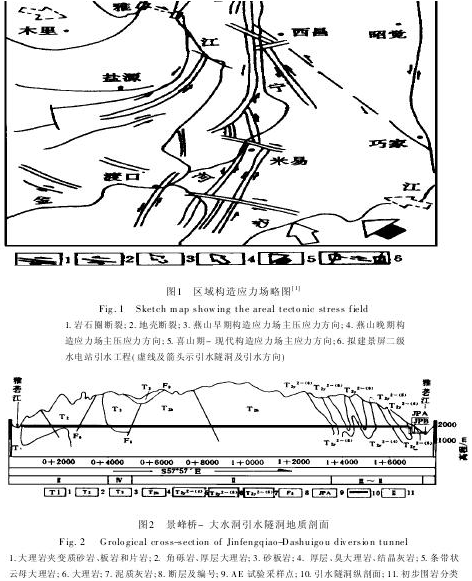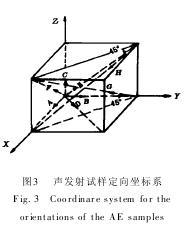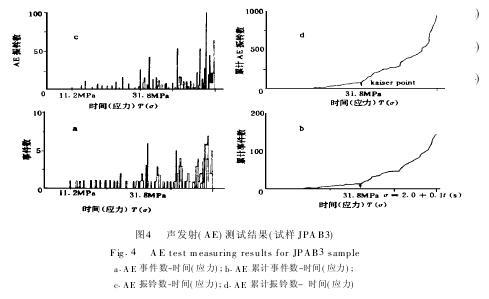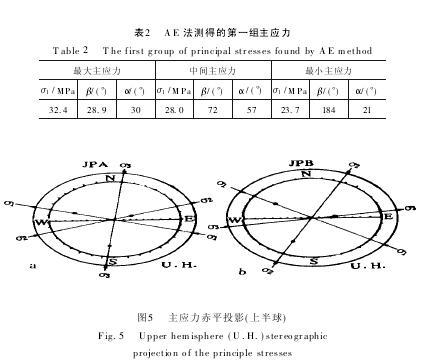Pick to tectonic stress field in this paper, on the basis of the geological mechanics analysis combined with acoustic emission (AE) method for water diversion area caving marble directional sample determination of in-situ stress experiment, preliminary study on ground stress field in the area, and compared the macroscopic geological mechanics analysis and should force measurement results, the relationship between the AE method to the problems existing in the determination of in-situ stress are discussed.
Keywords geostress acoustic emission analysis of geological mechanics
1 lead it
Silk screen is secondary hydropower cascade development of the yalong river downstream in the western China plans to build one of the water conservancy hub project, hydropower resources for high head low dam diversion type power station. The plant proposed Victoria towers bridge - big ditch diversion tunnel 17 ~ 20 km long, maximum depth of 2500 m, average depth of about 1500 m. To build the special ultra deep water diversion tunnel exist some technical problems. The first is how to decorate the hole axis according to the in-situ stress characteristics, which determine the section size and lining structure. Previous studies mainly with the aid of remote sensing images and ground survey geological mechanics analysis of the structural feature, the lack of direct measurement of quantitative data of in-situ stress, so as to bring the design and construction of the water diversion project certain difficulties.
2 analysis of regional tectonic stress field
Region of neotectonic movement in the research results show that: [1] in this area has experienced yanshan stage well-developed two tectonic stress action (figure 1). The early yanshan movement, regional tectonic stress direction for the NWW to SEE; Late to late into NNW to SSE to; Himalayan period, regional tectonic stress for NW300 ° ~ 330 ° - SE120 ° ~ 150 ° direction. Studies have also shown that [2], this belongs to active seismic region plays a role of constraints to send all kinds of engineering construction in the region tectonic stress field is a new generation of Himalayan movement since the formation of the modern tectonic stress field.
From reflected in the water diversion tunnel in the structural feature of the distribution features of the rock, the late Triassic EW indosinian movement to (NWW to SEE to) principal compressional stress field in the region to form a series of near SN to close double fold and fracture distribution, with late yanshan movement have different degree of modification (figure 2).

These belong to qualitative evaluation of the tectonic stress field of the macroscopic geological mechanics analysis, quantitative evaluation, using acoustic emission experiment method to determine the orientation of rock specimen \"memory\" of ground stress, specify the modern stress field in diversion tunnel area reflected stress size, orientation and provide necessary basis for tunnel design and construction.
Determination of three acoustic emission experiment
3.1 AE sites
In accordance with the test outline, this experiment in Victoria towers proposed bridge - big ditch diversion tunnel NE side within 5 km long big ditch speleology, since the hole distance of 600 m test tunnel group Triassic middle salt pond (T2 - (5) 2 y) in the marble samples.
3.2 sampling and test
Field orientation sampling in the two groups. The first set of sample Numbers for JPA, lithology as the gray, coarse crystal white marble, sampling depth of 600 m, sampling drilling drilling azimuth Angle is 343 ° (N17 ° w), borehole axis 4 ° Angle. A second set of sample Numbers for JPB, lithology for grey - spotted a dark gray color ribbon marble, sampling depth of 480 m. Sampling drilling azimuth Angle 180 ° (S). Two groups of rock lithology, structure, tectonic characteristics of differences. The former uniform texture, composition of a single, common crystallization; In the preparation of good eight direction meter 41 specimens, in addition to the 13 specimens of calcite vein filling sparse small cracks and syngenetic sutures seam outside, the rest strength is higher. The latter texture inhomogeneity, mainly by the light grey, grey marble microtek containing calcium heavier and dark gray or black argillaceous limestone of aphanitic or fine grain; Deep and shallow material contact surface wave ups and downs, as the weak surface; Specimen saw a calcite filling fine hair on the cylindrical shape micro cracks.
3.3 test method
First of all, on the core drill specimens respectively along eight direction (figure 3). Then, sawing mill forming, the end bonding briquette, in natural curing 4 days. Finally, in the INSTRON rigid servo press, uniaxial loading, use of AET - 5000 - b acoustic emission detection of acoustic emission signal analysis system. By using attenuator exhaust noise exhaust noise effectively, retain only acoustic emission detection signal from the specimen itself (figure 4). Among them, the Kaiser (Kaiser) corresponding stress of the specimen were specimens with axial pressure, is the one-way normal stress.

3.4 calculation method
Because the rock physical and mechanical properties of anisotropic and different
The differences of nature of the sample, and because of rock specimen in obvious cracks or weak surface, often loaded first or load stress is small creates more AE, belies the Kaiser point, such as specimen JPBF4. So, to determine the number of in-situ stress of more reliable, the measured value of AE samples first for analysis of mathematical statistics, a weighted average of the calculated stress. Then a weighted average normal stress measured eight direction sigma I (I = 1, 8) into (1)

8 a system of linear equations, using the least squares solution of the right Angle coordinate system of six unknown stress component. Finally, according to the type (2) ~ (4) to solve the principal stress value and its core coordinate system x, y, z - 0 on the direction cosine, then convert to the geographic coordinates, calculate the azimuth Angle and dip Angle of principal stress.


3.5 test results
The first set of samples (JPA), the result is shown in table 1, table 2 and figure 5 a, a second set of samples (JPB) result is shown in figure 5 b.


3.6 the analysis and conclusion
(1) the first group, the same direction different specimen measured by AE method of one_way normal stress relative error is 5% ~ 5%, show that the direction measurement value can reflect the same rule. (2) from table 1, the first group of one_way back calculation values of normal stress and the relative error between the measured value is. Data show that eight direction coordination, and disproving the Kaiser effect has the direction of independence. By (1), (2) analysis is the result of the first group of AE method is reliable. (3) with a second group of rock specimen contains a lot of weak plane and more obvious crack, as previously mentioned AE measurement values are not reliable. As a result, the conclusion is available AE determination of in_situ stress: the stress magnitude and direction of AE measurement with grey - white coarse grained smelly marble according to measurement shall prevail; (2) determination of AE reflected the direction of principal compressive stress field for N71 ° W ~ S71 ° E to the maximum and minimum principal stress sigma 1, sigma 3 of less than 30 ° inclination, nearly level, and the intermediate principal stress sigma 2 Angle 45 °, nearly vertical.
The determination of AE conclusion must be decided with the rock acoustic emission characteristics of in_situ stress measurement of area geological mechanics environment, and comparison with other in_situ stress comprehensive test results, comparative, choice.
4 AE in-situ stress experiment results and the analysis of the relationship between the geological mechanics
In short, (1) the AE testing scheme is on the basis of the regional stress field geological mechanics analysis, combined with the specific requirements of the water diversion project design. (2) the AE testing is on the water diversion project specific validation of tectonic stress field analysis of geological mechanics. Test results show that the proposed within the scope of the tunnel, AE experimental determination of the biggest, in the middle, the minimum principal stress direction and the measurement area is consistent with the geological mechanics environment.
Five main problems of AE method determination of in-situ stress
By the AE measurement, AE method determination of in-situ stress seems to exist to solve the problem of the following:
(1) the Kaiser effect to solve the uniqueness of the argument;
(2) sample Kaiser effect shows that the one-way pressure conditions and rock mass of the original three memory formation to the difference of pressure conditions;
(3) the intensity of rock AE memory and influence factors;
(4) sample processing.







